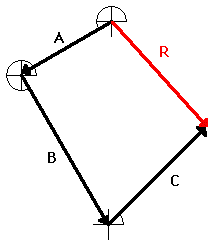Laws of Mechanical Action
As further basis we have proved laws of mechanical motion.
The form in which they are stated here was selected with a view toward their relationship to the problems of piano-technique.
The laws of mechanical action as stated here are viewed in relation to piano technique.
- A body at rest remains at rest unless acted upon by an external force.
- A change in speed or direction of motion of a body results from the action of a second force, the first force producing the original motion.
- The total effect of a force depends upon three things:
- Its numerical value,
- Its direction, and
- Its point of application.
- The action of forces need not always produce motion. Two forces, equal and opposite, neutralize each other and do not produce motion.
- The speed and direction of a body, unless the component forces be known, is not in itself an index of the forces acting upon the body.
A force of 5 in the absence of all other forces will produce the same motion in a given body as a force of 10 opposed by a force of 5, other things equal. - The numerical value of a force[1] depends upon the mass and the speed of the body producing it.
- A force always produces motion in the exact line of its action, unless otherwise interfered with.
- The force of gravity influences all motion. It acts vertically downward. Its value and direction are constant, the former for any given locality, the latter for all localities.
-
Rectilinear vs. Curvilinear Motion: Motion that takes place along a straight line is called rectilinear motion.
Motion along a curved line is called curvilinear motion.
When a body turns upon any axis, real or theoretical, motion of rotation results.
When a body as a whole changes its spatial relationship to surrounding bodies, motion of translation results.
Both types of motion may be present at the same time, in equal or in unequal degrees. - A force whose effect is the combined effects of several forces is called their resultant. [2]
The forces producing the resultant are called the components.[3] - The mutual reactions of two bodies on each other are always forces equal in amount and opposite in direction.

[2]resultant: The resultant is the vector sum of two or more vectors. It is the result of adding two or more vectors together.
If displacement vectors A, B, and C are added together, the result will be vector R. As shown in the diagram, vector R can be determined by the use of an accurately drawn, scaled, vector addition diagram.
[3]components: Draw coordinate axes on the free-body diagram. Decompose the forces acting on the object into x and y components. Calculate the x and y components of the resultant force by adding the x and y components of all forces.
Finally, find the magnitude and direction of the resultant force by using its x and y components.